MXA INTERVIEW: TONY DISTEFANO TALKED TO GOD
 Classic Tony D: Open-face Bell helmet, Scott goggles, Full House leathers, Full Bore boots and hand-cut number 3s.
Classic Tony D: Open-face Bell helmet, Scott goggles, Full House leathers, Full Bore boots and hand-cut number 3s.
BY JIM KIMBALL
Photos by Jim Gianatsis, Jody Weisel and MXA Archives
TONY, WHAT WAS YOUR FIRST MOTORCYCLE? I don’t know. My dad brought it home from the motorcycle shop he owned. It was a little Italian-made, suitcase mini-cycle. It had almost square tires and was very low to the ground. At first, I could barely ride it, but I was only 5 years old. I just putted around on it. I didn’t race my first race until I was 8 years old.
WHAT DID YOU RIDE AT THAT FIRST RACE? It was a Yamaha 60. At 9 years old, I got a Yamaha 100 Twin. A guy named Ray Martino, who was a mechanic at my dad’s shop, a local racer and family man, became my mentor. I raced originally as an Amateur and then turned Expert. It was not like going to a motocross race today. Back then, you had guys who would ride their bikes to the track and tape a pie plate on their headlight to use as a number plate. It was a motley crew.
HOW DID YOUR RACING PROGRESS? AMA District 6 was where I was from, and they had lots of scrambles tracks. This was a bit before motocross. I was a good scrambler, not aggressive but very smooth. It didn’t seem like motocross would be my thing, because I was not physically coordinated. I was a chubby kid.
BUT, MOTOCROSS DID BECOME YOUR THING. Motocross seemed like a tough sport and too physical for me initially, but I took to it like a fish to water. As I got older, I developed more of a man’s body and thinned out. Most of the guys I was racing against were much older than I was.

DO YOU REMEMBER YOUR FIRST PRO RACE? Yes. I could not even sign myself up. My sister would sign me up. I was 14 years old and racing in the Expert class. Ray Martino had started a little CZ shop. At the time, you only needed to buy two bikes and some accessories to be a CZ dealer. We decided to race the Unadilla Trans-AMA, but I was too young to race an AMA Pro race, so I signed up under the name Carl Dockerty, who was a friend of mine.
RACING TRANS-AMA AT 14 YEARS OLD IS CRAZY! HOW DID YOU GET AWAY WITH IT? People wanted me to race with the big boys. They said, “Go ahead, Tony. We will sign you up, and you can race.” They wanted to see if I got spanked or was any good. The next year my dad got me a phony driver’s license. I was 15 then, but the AMA age limit to race was 18.
WERE YOU ABLE TO KEEP YOUR AGE A SECRET? For a while, but I started winning too many races. Honda Hills was a big one. I rode both the 250 and 500 classes, but then someone got jealous and turned me in. The AMA fined me $50 and banned me until I was of legal age. But, my timing was perfect because they dropped the AMA legal age to 16 years old the next year. I turned 16, got my driver’s license, and had earned enough money racing to order a brand-new van. I was so happy when I could drive myself to the races and not rely on anybody.
DO YOU MEAN THAT YOU WERE RACING THE AMA NATIONALS ALONE AT 16? Yes. When you look back on it, you have to wonder why no one questioned why a 16-year-old was sleeping in a van and out on the road by himself. I admit that it was scary at times.
 Tony DiStefano raced an antiquated Czechoslovakian CZ to the 1974 500 National points lead. Unfortunately, he broke his thumb and had to race the next five Nationals with a cast on his hand, but still ended up second overall as a privateer.
Tony DiStefano raced an antiquated Czechoslovakian CZ to the 1974 500 National points lead. Unfortunately, he broke his thumb and had to race the next five Nationals with a cast on his hand, but still ended up second overall as a privateer.
“PEOPLE WANTED ME TO RACE WITH THE BIG BOYS. THEY SAID, “GO AHEAD, TONY. WE WILL SIGN YOU UP, AND YOU CAN RACE.” THEY WANTED TO SEE IF I GOT SPANKED OR WAS ANY GOOD.”
WHAT ABOUT SCHOOL? When I was racing the Nationals, I was still in school and would always miss Monday. I would leave after school on Friday and drive to wherever the race was. The longer trips to Florida, Texas or Michigan were hard. I could no longer do any school sports, but as that first year wore on, I started to get closer to the top five. Later that summer I came close to some top fives.
WHEN DID YOU REALIZE THAT YOU WERE GOING TO MAKE IT? When the 1973 Trans-AMA series started in the fall, I started knocking on the door of the top five and was consistently in the top 10. I loved racing against the good guys! But, it was 12 weeks straight away from home. The Trans-AMA series went to Northern California late in the year, and there were some very cold nights in my van. I knew a racer who put one of those little Coleman heaters in his van and suffocated to death.
THAT WAS 1973. HOW DID 1974 BEGIN? I stopped going to school and spent all my time training. I got serious about motocross. I went to the Florida Winter Series and kicked butt. Guys like Mark Blackwell were down there, and I liked watching him ride. He was nice, smooth and so good. I won the Florida series. I was 17 years old and still sleeping in my van.
When the 1974 AMA 500 Nationals started, I got second at Hangtown, won the second round at Baymare, California, finished third at Red Bud, won at Appalachia Lake, West Virginia, and was leading the 500 National Championship. Unfortunately, I broke my thumb at a local Indian Dunes night race and was forced to race the next five 500 National with my hand in a cast. I got a sixth in Hammersville, Ohio; sixth again in Delta, Ohio; fifth in Mexico, New York; second at Highland Hills, Ohio; and finished the 500 series with a fourth in New Orleans.
My main competition in the 1974 500 National Championship was Jimmy Weinert, and he won four of the five races that I rode injured to win the title. I ended up second overall. It was near the end for CZ, because the Japanese brands were getting into it. Husqvarna and Maico were still competitive, but by 1975, the Japanese bikes were best. My CZ was obsolete. It was heavy, but it was as reliable as could be.
SUZUKI SIGNED YOU FOR THE 1975 SEASON. HOW DID THAT COME ABOUT? I was beating everyone on a CZ in 1974. No one believed that a CZ could win, so that enhanced their opinion of the guy riding it. In 1974, I won two 500 Nationals and had a big points lead until I broke my thumb. Suzuki saw that. Getting on a Suzuki for 1975 was great! That was the bike to have. It was so light, like a toy. I raced the RM370 in the 1975 Florida Winter Series. Billy Grossi was my teammate, and he raced the 250 class. I ended up winning the series. If my bike was running, I was winning.
Then, when the 1975 AMA 250 National Motocross Championship came around, I won that series. Later in 1975, I won the Inter-AMA series. Suzuki had signed me to be a 500 rider, so when the 500 series started, I went to Kansas and thought, “Okay, this is the class I am really supposed to race.” But, at the third race, while leading by 30 seconds with two laps to go, I put my foot out going around a big sweeper. Something caught my boot and hurt my knee. I just pulled over and could not believe how much pain I was in, but I got going again and finished second.
The Honda guys helped me tape my knee up, and I finished the second moto decently and was leading the series with two more races to go. When I got back home, I went to an orthopedist who recommended that I have knee surgery.
 Out of the four years at Team Suzuki (from 1975 through 1978), Tony won three consecutive National Championships. However, after suffering a knee injury in 1979 and missing most of the season, they fired him.
Out of the four years at Team Suzuki (from 1975 through 1978), Tony won three consecutive National Championships. However, after suffering a knee injury in 1979 and missing most of the season, they fired him.
DID YOU GET KNEE SURGERY? No. I was young and stupid, so I kept racing. I could take pain, which I feel goes with being tough and self-reliant. Traveling alone in my van and working on my bikes made up my whole character. In the end, I had all my National Championship years while riding with a bad knee.
I give myself some credit. I was smart enough to change my riding style and become more conservative. Jody would always tell me that I had “no style”—compared to the flashy guys. I would tell him, “I’ll do my styling at the bank.” My contract was to win races and Championships, not to do whips. That is what I focused on. I won the 1975 AMA 250 National Motocross Championship, the 1975 Inter-AMA, and finished third in the Trans-AMA series.
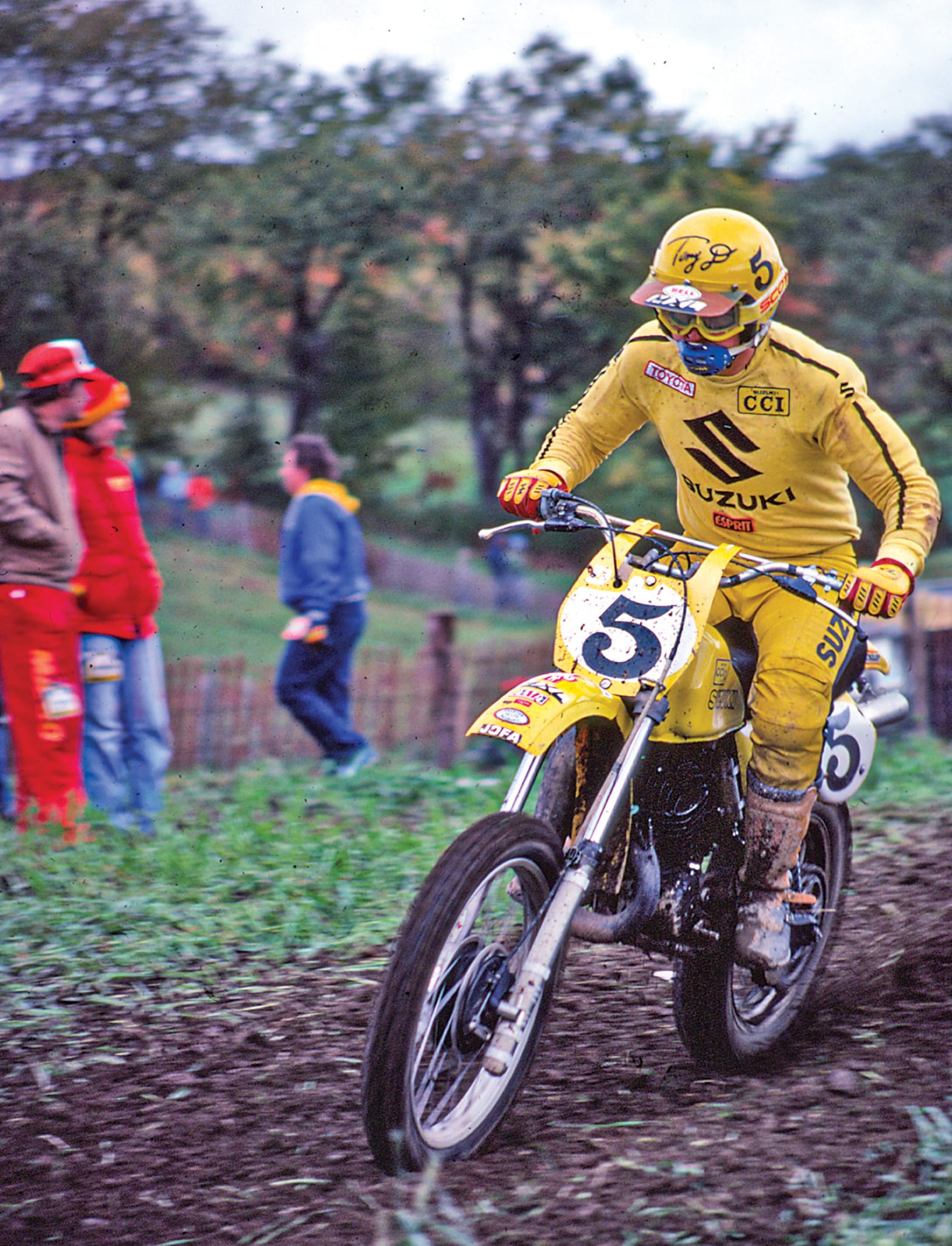 Tony won three 250 National Championships, the Daytona Supercross, three Trans-AMAs, the 1975 Inter-Am series and was on four Motocross des Nations teams.
Tony won three 250 National Championships, the Daytona Supercross, three Trans-AMAs, the 1975 Inter-Am series and was on four Motocross des Nations teams.
“I WAS HIRED TO WIN THE AMA 500 MOTOCROSS CHAMPIONSHIP, BUT JUST COULDN’T WIN IT OR THE 250 SUPERCROSS TITLE. I DID WIN THE 1976 DAYTONA SUPERCROSS AND THE 1977 HOUSTON ASTRODOME SUPERCROSS.”
FINISHING THIRD IN THE TRANS-AMA WAS HUGE FOR AMERICAN MOTOCROSS! I wanted to do well in the Trans-AMA. Brad Lackey and Jim Pomeroy were back home from Europe, and this was their time to shine for the home crowd. All the top Grand Prix guys were there. I took it very seriously. I won three rounds that year, and at Saddleback I won both motos. I probably could have won four Trans-AMAs that year, but Roger DeCoster came over to me at the Washougal round and said, “Tony, you are going good, but I have a chance to win the Trans-AMA title. If you could pull over or anything that would help.” So, I let him by.
You have to understand, Roger did not talk to me that much during the Trans-AMA. It was like God was talking to me. Fortunately for him, he got the Trans-AMA title; however, at the next race, his bike broke in half at Livermore. That was the first Suzuki to have the front end snap off, but there were several more big incidents, including my forks breaking off at the Dallas Supercross.
IN 1976 AND 1977, YOU WON THE AMA 250 NATIONAL CHAMPIONSHIPS. WHAT ABOUT SUPERCROSS? Supercross was starting to grow, but to most of the established racers, it seemed like the lesser series. I was hired to win the AMA 500 Motocross Championship, but just couldn’t win it or the 250 Supercross title. I did win the 1976 Daytona Supercross and the 1977 Houston Astrodome Supercross.
WEREN’T YOU THE FIRST RIDER TO DEVELOP HIS OWN GEAR LINE? Yes, that’s a part of my story that people laugh at. They thought the clothes were ugly. Motocross gear was in its infancy. I wanted my gloves and pants to be designed to fit best when you were in the riding position. A company named Full House was a local distributor that sponsored me. They owned the gear brand, but I developed the products and got royalties. Lackey made fun of my gear, but I was making money on it!
HOW MUCH WAS SUZUKI PAYING YOU? In my first year, I was paid $10,000 in start money. That meant no guaranteed money if you didn’t race. A win bonus was $300 for a National and $400 for a Trans-AMA. The Championship bonus was $10,000. There was also “First American” money for the Trans-AMA series and bonus checks from sponsors. It seems like a pittance compared to what the riders make today, but it was 1975. Gasoline was 40 cents a gallon, the average income was $11,000 a year, and you could buy a house for under $30,000.
I would have done it for free, but I made like $20,000 that first year. After I won my 1975 Championship, I told Suzuki I wanted a $20,000 salary, plus $20,000 Championship bonuses and win bonuses that added up to $30,000. My second year at Suzuki I made $75,000—not counting my sponsorship deals. My biggest Suzuki contract was for $40,000 with guaranteed money, but I made more money from sponsors and royalties on products, which nobody else was getting.
YOU HAD A PRESTON PETTY PLASTIC CONTRACT, RIGHT? Yes, the Preston Petty fender made me a lot of money. It was the fender that everyone ran on their bikes in the 1970s. Unfortunately, I had a falling out with my mechanic over that fender. My works Suzuki had a terrible front fender. It was all riveted together and flimsy. The Preston Petty “Tony D fender” was good. Preston sent me the latest version, and I put it on my bike. It broke off in the mud at Unadilla. I should not have tried it there. My mechanic Keith McCarty refused to put it on, so I put it on myself.
DID YOU REALLY LOSE KEITH McCARTY OVER THAT? Not really. He got a better offer to switch to Yamaha. We are still buddies. He got with Hannah, and it could not have worked out better for him at Yamaha. Nobody ever stayed at Suzuki, and nobody who worked there ever got moved up to a better job. Look, my best years were at Suzuki, but that was a screwed-up company.
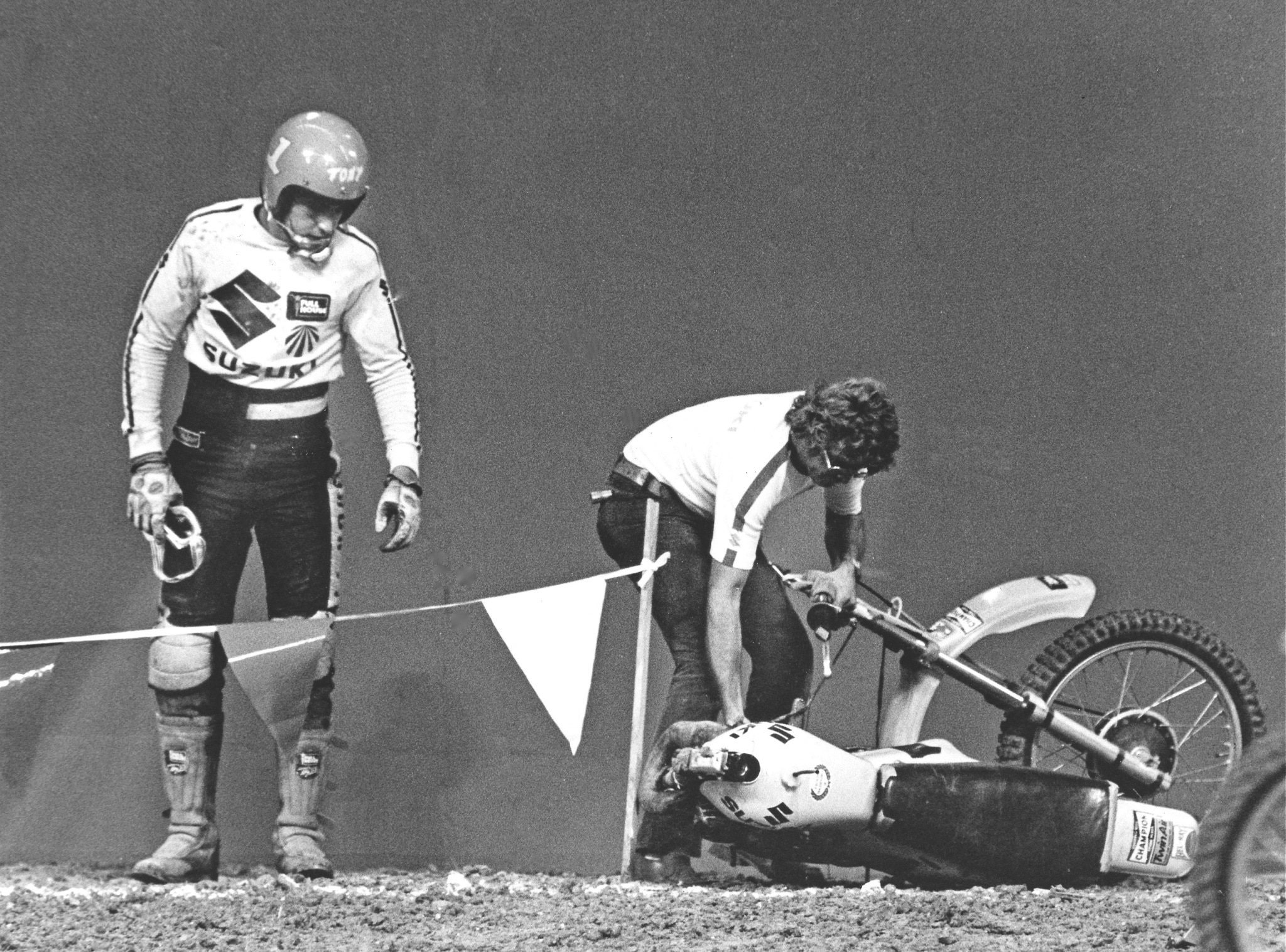 Roger DeCoster’s Suzuki forks broke off at the 1975 Livermore Trans-AMA, Danny LaPorte’s Suzuki fork broke at the 1976 Florida Winter Series, and, in spectacular fashion, Tony D’s forks broke off in a brutal crash at the 1976 Dallas Supercross (when he was leading the AMA Supercross Championship).
Roger DeCoster’s Suzuki forks broke off at the 1975 Livermore Trans-AMA, Danny LaPorte’s Suzuki fork broke at the 1976 Florida Winter Series, and, in spectacular fashion, Tony D’s forks broke off in a brutal crash at the 1976 Dallas Supercross (when he was leading the AMA Supercross Championship).
WHY DID SUZUKI LET YOU GO AFTER THE 1978 SEASON? Out of the four years I raced for Suzuki (from 1975 through 1978), I won them three 250 National Championships in a row. The one year that I didn’t win a Championship was because I hurt my knee one week before the Championship started. I couldn’t race to my capabilities and finally had to get surgery on it. I came back late in the year. I was the defending Champion in 1978, but to them it was like I was never there.
They fired me, but they said they were being nice to me, and they liked me. Hannah won everything in 1978, including Supercross, which the manufacturers started to put more emphasis on. At the end of the year, Honda talked to me, but they tried to lowball me. They had talked to me a few times throughout my career, but back then I was very loyal to Suzuki.
YOU SIGNED WITH CAN-AM IN 1979. WHAT HAPPENED THERE? When Can-Am had Jimmy Ellis, they were good, but Can-Am stopped development on their bikes, and the race bike had a lot of deficiencies. I did five Supercrosses and six Nationals on the Can-Am and then they quit—they just stopped. Luckily, Mitch was there to help me.
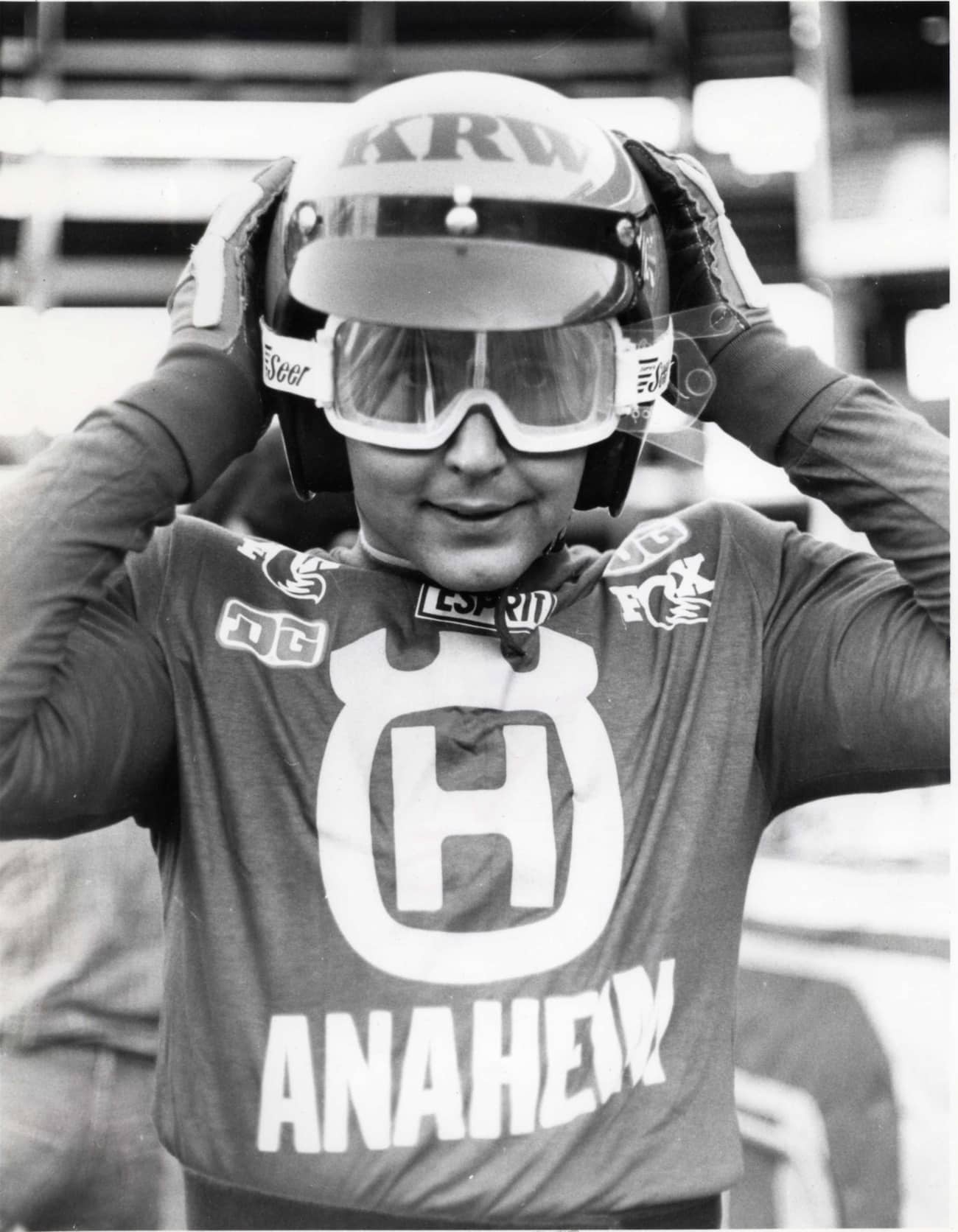 Tony raced for Mitch Payton’s Anaheim Husqvarna team in 1979. It was a shortlived ride because Tony suffered a devastating eye injury before the 1980 season started.
Tony raced for Mitch Payton’s Anaheim Husqvarna team in 1979. It was a shortlived ride because Tony suffered a devastating eye injury before the 1980 season started.
DO YOU MEAN MITCH PAYTON OF PRO CIRCUIT FAME? I was staying with Jody, and he was friends with Mitch Payton, who had a small Husqvarna shop in Anaheim. Mark Blackwell was at Husqvarna, and he got me some bikes after Can-Am disappeared. Jody suggested that I let Mitch work on my Husqvarnas, and Mark Blackwell was okay with that. Mitch had me race all the local Pro races at Saddleback and Carlsbad to adapt to the Husky, get some seat time and to test setups for the upcoming Anaheim Supercross, which was in November in 1979. I did decent there and was top 10.
 A workshop accident cost the three-time 250 National Champion the sight in his right eye, but Jody made him laugh. Tony would make a comeback and race with one eye.
A workshop accident cost the three-time 250 National Champion the sight in his right eye, but Jody made him laugh. Tony would make a comeback and race with one eye.
TELL US ABOUT YOUR EYE INJURY. I was installing shelves in my garage right after the Anaheim Supercross, and the long screwdriver I was using slipped and cut my eye. I lost all of the 1980 season, but I still wanted to race, so I put a patch over my bad eye and rode with one eye. For 1981 I was on a Maico. The first couple of races were disasters. It was hard to adapt to my depth perception with only one eye. I may have been in the top 10 as a privateer racing with only one good eye, but I had been a Champion. So, I figured that was it. I gave it a try; it did not work out, and that is when I started my motocross schools.
WERE THE SCHOOLS REWARDING? I enjoyed it. Suzuki sponsored my schools. I liked teaching and found my niche being the coach to “Beginner, Novice and Intermediate riders.” Those were the bulk of the students. I loved working with them.
TELL US ABOUT THE CRASH THAT PARALYZED YOU. It was Thursday, and I had not been on a bike for a few weeks before that. I have been riding since I was 5 years old, and I have crashed 10 times worse than that many times. My rear wheel hit a stump hidden on the edge of the track and I high-sided. The only visible damage was that my visor was broken, but my spine was also broken at T-5, the nipple line. At the hospital, the doctor called it a “complete break,” which means no feeling, no bowels, no bladder. My daughter was nine days old. There were only six regional spinal-cord clinics in the U.S. at the time, but luckily Philadelphia had one of the best ones. Being an athlete, I would have gone wherever was best, thinking I could heal, but the spinal cord is the one bad design that the good Lord did. Everything can heal except your spinal cord.
WERE YOU THINKING ABOUT CONTINUING WITH YOUR MOTOCROSS SCHOOLS? Yes. I was in rehab when Suzuki called me about doing next year’s contract. They asked, “Can you do this, Tony?” I said, “I can’t even put my underwear on right now, but by spring I’ll be ready to go.” They gave me all my money. Suzuki was great to work with. My other sponsors stuck with me, and I was back in six months. Suzuki stopped supporting the schools in 2008/2009, but I kept teaching until 2012. Eventually, the economy went bad, and a motocross school is a luxury. It is not something people have to do.
“I WON THREE AMA NATIONAL MOTOCROSS TITLES. PEOPLE PAID TO COME TO MY SCHOOLS.THEY WERE ENTHUSIASTIC. THEY WANTED TO COME.”
EVERYONE WAS IMPRESSED THAT YOU REBOUNDED SO FAST. I have always been an outdoor guy. I was not happy being paralyzed, but I had the motivation to keep working. Thank the Lord, my kids were also my motivation. What would it be like to have them say, “My dad gave up”? That would be wrong. Really, that was my main motivation.
DO YOU HAVE ANY REGRETS ABOUT YOUR CAREER? No. I lived more than two lives, more than I could have ever expected. I am glad that I did everything I wanted to do. Make no mistake, I don’t like being paralyzed. I can’t walk, but here is the deal, most people never have to think about mortality unless they are depressed or have mental problems. If I don’t do anything, my body feels terrible. I have all these different phantom pains. I block that stuff out by keeping busy. I was so fortunate. I won three AMA National motocross titles. People paid to come to my schools. They were enthusiastic. They wanted to come. I was giving them their dollars’ worth, and they were giving me even more.


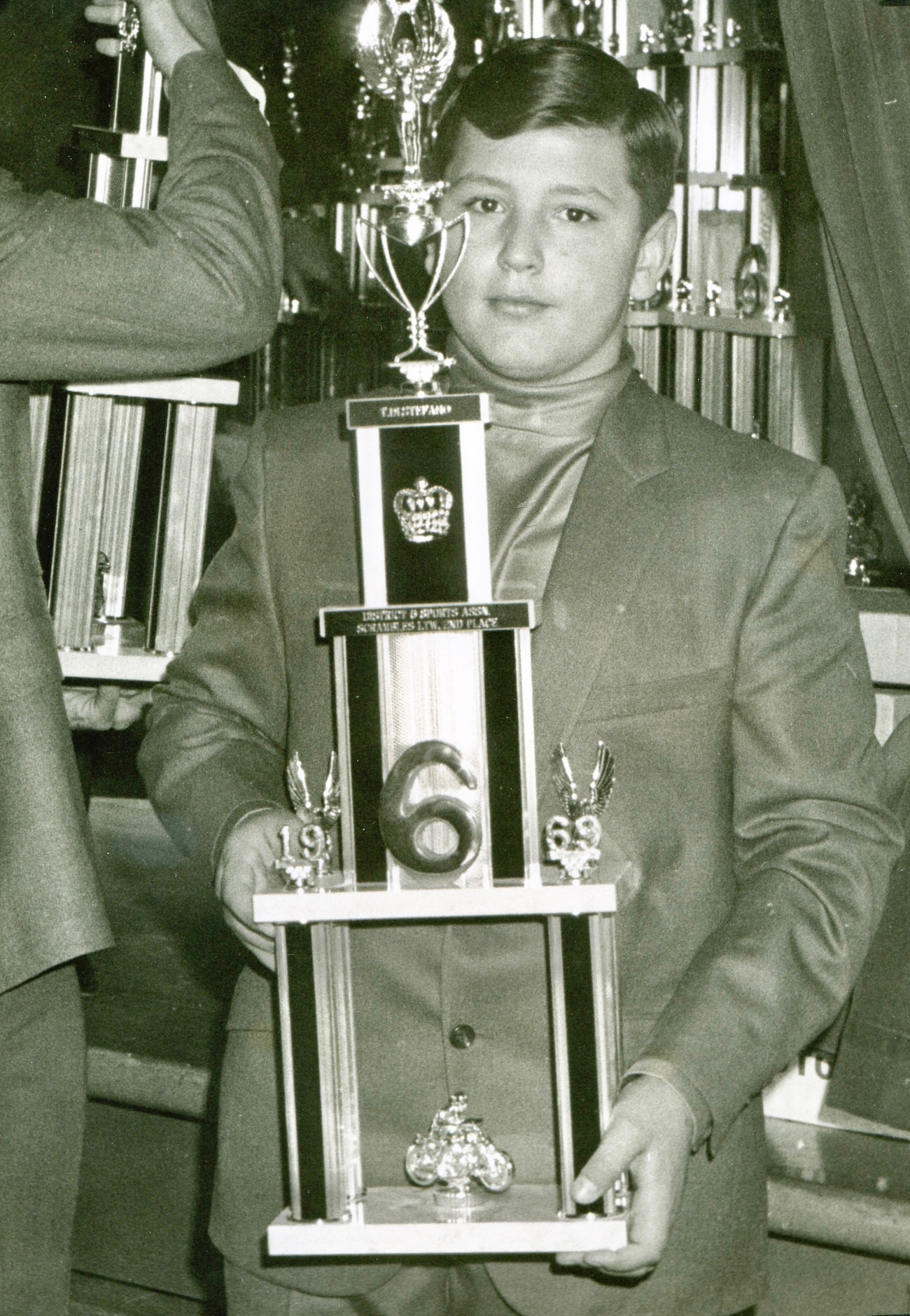


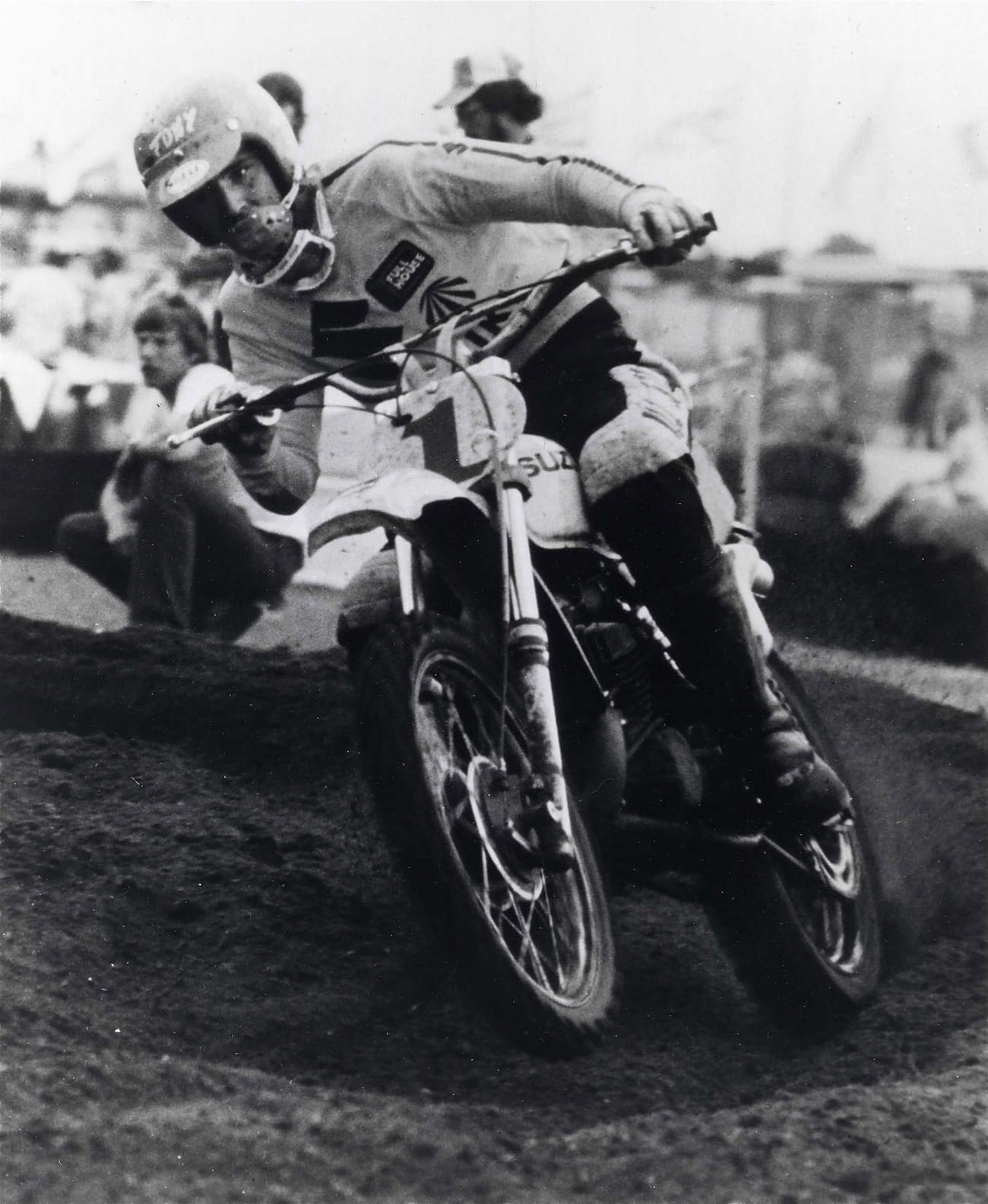





Comments are closed.